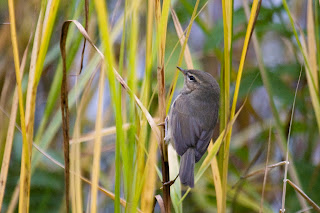Well, to celebrate my 40th birthday, I wanted nothing more than to run away from home and just be with my family. The plan, or rather my wife's plan, was to go to Bornholm... but about a week before this trip, she told me that I could choose, as a birthday gift, between a new camera house or a longer trip. To the Canary Islands and Lanzarote in particular. The choice was easy. I mean, my camera might be old (bought in 2006) but it still works fine, so I didn't take me five seconds to decide.
Of to Lanzarote and the town Costa Teguise. I had done some homework as to which birds might be possible to see. However, it was never going to be a birding trip but a social trip instead. Though we planned for at least one day with a rental car to see some of the island. Because of the quite cold temperature we actually rented a car twice.
So, as for birding, there were definitely some interesting birds to see. I thought that I should be able to get possibly three new lifers and perhaps as many as five. Well, three I managed but five proved difficult.
First there are some photos from the area surrounding Costa Teguise and then some from other parts, which we reached by car.
 |
| Whimbrel (småspov, Numenius phaeopus) |
 |
| Yellow-legged Gull (medelhavstrut, Larus michahellis atlantis) |
 |
| Ruddy Turnstone (Roskarl, Arenaria interpres) |
During this bike ride I also saw a large Tern. Probably a Caspian but I could never get a good enough look at it.
 |
| Clouded Yellow Butterfly (rödgul höfjäril, Colias croceus) |
 |
| Willow Warbler (lövsångare, Phylloscopus trochilus) |
 |
| Willow Warbler (lövsångare, Phylloscopus trochilus) |
 |
| Swift sp. (seglare, Apus ??) |
This is the only photo I have of this Swift and when I checked my Collin's guide after the trip I realised that there is this Plain Swift in the Canary islands. This could very well have been one but I didn't think to check while still on Lanzarote. Not good...
 |
| Spanish Sparrow (spansk sparv, Passer hispaniolensis) |
 |
| Southern Grey Shrike (iberisk varfågel, Lanius meridionalis) |
 |
| Berthelot's pipit (kanariepiplärka, Anthus berthelotii |
 |
| Trumpeter Finch (ökentrumpetare, Bucanetes githagineus) |
Other birds close to Costa Teguise were Linnets, Kestrels, House Martins, Feral Doves and one White Wagtail
As I mentioned, during two days we rented a car and drove around the island. We visited the market in the town Teguise (where I saw a Hoopoe) and then drove around the norhern part of the island. First thing after Teguise was to drive over the plain of El Jable. The obvious target species being the Houbara bustard, of course. Well, I wasn't lucky... no bustards could be seen. But plenty of Berthelot's pipits and Lesser Short-toed larks. On the other side of the plain, just by the town of Sóo, I finally saw my first Trumpeter finch.
 |
| Overview of the plain of El Jable from the town Teguise |
The plain between Teguise (from where this photo is shot) and the town on the other side is supposed to be one of the best places for the Houbara bustard
Tja
 |
| Hoopoe (härfågel, Upupa epops) |
Tja
 |
| Trumpeter Finch (ökentrumpetare, Bucanetes githagineus) |
Tja
 |
| Lesser Short-toed Lark (korttålärka, Calandrella rufescens) |
Tja
 |
| Egyptian Vulture (Smutsgam, Neophron percnopterus) |
After the El Jable plain, we drove to the lookout point of Mirador del Rio. I got my first really good view of a Berthelots't pipit here but didn't manage to take a photo of it.
 |
| Painted Lady (tistelfjäril, Vanessa cardui) |
On my 40th birthday, I drove again to El Jable plain. I didn't want to give up on the Houbara bustard so we rented a car the evenening before so I could get out early in the morning.
 |
| Berthelot's pipit (kanariepiplärka, Anthus berthelotii |
Tja
 |
| Berthelot's pipit (kanariepiplärka, Anthus berthelotii |
Tja
 |
| Houbara Bustard (ökentrapp, Chlamydotis undulata) |
 |
| Houbara Bustard (ökentrapp, Chlamydotis undulata) |
Tja
 |
| Cream-colored Courser (ökenlöpare, Cursorius cursor) |
I've seen the Cream-colored Courser before, in Dubai, but never as close as here.
Tja
 |
| Cream-colored Courser (ökenlöpare, Cursorius cursor) |
Tja
 |
| Cream-colored Courser (ökenlöpare, Cursorius cursor) |
Tja
 |
| The dramatic view of the west coast of Lanzarote. Beautiful! |
 |
| Hej |
Other birding spots which should be mentioned would include the Salinas de Janubio. We stopped very shortly beside the salinas but I soon realised that a spotting scope would be of great use here. I did see a family of Ruddy Shelducks but nothing more during my short stay.
List of birds seen on Lanzarote:
Berthelot's pipit (kanariepiplärka, Anthus berthelotii)
Spanish Sparrow (spansk sparv, Passer hispaniolensis)Collared Dove (turkduva, Streptopelia decaocto)
Whimbrel (småspov, Numenius phaeopus)
White Wagtail (sädesärla, Motacilla alba)
Kestrel (tornfalk, Falco tinnunculus)
Southern Grey Shrike (iberisk varfågel, Lanius meridionalis)
Linnet (hämpling, Linaria cannabina)
Swift sp. (seglare, Apus ??)
House Martin (hussvala, Delichon urbicum)
Willow Warbler (lövsångare, Phylloscopus trochilus)
Cattle Egret (kohäger, Bubulcus ibis)
Hoopoe (härfågel, Upupa epops)
Lesser Short-toed Lark (korttålärka, Calandrella rufescens)
Southern Grey Shrike (iberisk varfågel, Lanius meridionalis)
Egyptian Vulture (Smutsgam, Neophron percnopterus)
Trumpeter Finch (ökentrumpetare, Bucanetes githagineus)
Yellow-legged Gull (medelhavstrut, Larus michahellis atlantis)
White Stork (vit stork, Ciconia ciconia)
Ruddy Turnstone (Roskarl, Arenaria interpres)
Houbara Bustard (ökentrapp, Chlamydotis undulata)
Cream-colored Courser (ökenlöpare, Cursorius cursor)
Ruddy Shelduck (Rostand, Tadorna ferruginea)
Clouded Yellow Butterfly (rödgul höfjäril, Colias croceus)
Painted Lady (tistelfjäril, Vanessa cardui)

































